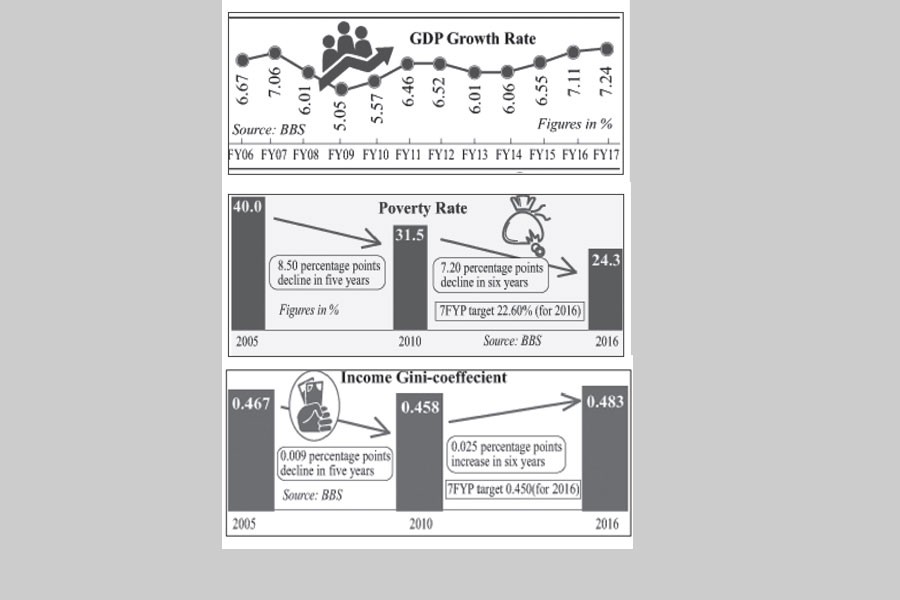Now this is official. Inequality has increased in the country as economic growth is moving upward. On one hand, the growth rate of Gross Domestic Product (GDP) surged to 7.11 per cent in FY16 from 5.57 per cent in FY10, and on the other, Income Gini Co-efficient increased to 0.483 in 2016 from 0.458 in 2010. Income Gini Co-efficient measures the income inequality. The higher the value moves toward 1.0 from 0.0, the higher the extent of income inequality.
True, poverty has declined during the period under review. Poverty rate declined to 24.3 per cent in 2016 from 31.5 per cent in 2010. Average GDP growth rate was 6.45 per cent in this period. But the pace of decline in poverty is slower than the previous five-year period when poverty rate declined from 40 per cent in 2005 to 31.5 per cent in 2010. Average GDP growth rate was 6.0 per cent during the period.
Thus despite higher growth, resource distribution became uneven. The latest report of the Household Income and Expenditure Survey (HIES-2016), released by the Bangladesh Bureau of Statistics (BBS) last week in Dhaka, unveiled the growing uneven socio-economic make-up of the country.
The latest HIES also showed that top five per cent of the households of the country now enjoy around 28 per cent of the total national resources which was 24.61 per cent six years back. At the same time, the lower five per cent of the households drastically lost their entitlement on national resources. It came down to 0.23 per cent in 2016 from 0.78 per cent in 2010.
The situation prior to 2010 was somewhat better. The top five per cent of the population owned around 27 per cent of the national resources in 2005 while the bottom five per cent owned 0.77 per cent. Thus, the situation of resource concentration improved during that period (2005-2010) which took a reverse turn in the subsequent years.
The main reason for widening inequality in the country is growth obsession. Policymakers have been pursing 'higher growth' or 'more growth' as the main objective of development. The underlying idea is that higher growth will ultimately trickle down and reduce poverty, which in reality is not as simplistic as many tend to believe.
Nevertheless, the growing inequality in the country is rightly acknowledged in the national planning documents. The Sixth Five-Year Plan (6FYP) said: "Income inequality is a serious problem in Bangladesh and reversing the trend in a sustainable manner will be a major challenge for the Sixth Plan."
But both the 6FYP and the 7FYP find the famous Kuznets hypothesis fully applicable to Bangladesh. The basic proposition of the hypothesis is that in the process of economic development, market forces first increase inequality and then decrease it. Thus, inequality becomes a by-product of growth and there is nothing wrong or worrisome on inequality. Though mainstream economists generally agree with the proposition, many oppose it. For instance, Thomas Piketty, author of Capital in the Twenty First Century, argues that growth fuels inequality unless addressed properly. Without adequate mechanism for balanced redistribution of the resources, higher growth leads to concentration of resources into limited hands.
The growth obsession is also reflected in the national planning documents. During the 6FYP, the target of the annual GDP growth rate was very ambitious. The actual growth rate in this period was well below the target. For instance, annual average actual growth rate was 7.28 per cent while the average actual rate was 6.33 per cent. The over-ambitious target was partly corrected later on. The 7FYP sets comparatively realistic annual growth target. The annual average growth target is 7.40 per cent in 2016-2010. In the first two fiscal years (FY16 and FY17), the target has been achieved.
Achieving the growth target is considered a very big success. But, neither the targets of poverty reduction nor lowering income inequality have been achieved. The 7FYP targets to bring down poverty rate at 22.60 per cent while the actual rate stood at 24.30 per cent in 2016. In a similar vein, Gini co-efficient increased to 0.483 against the target of 0.450 in the year. Failure to achieve the targets simply demonstrates that higher growth is not contributing towards balanced development.
Interestingly, the 7FYP presumes that income inequality would remain unchanged over the period of five years as it sets 0.450 as Gini co-efficient target for the period. But inequality reduces the prospects of increase in national income and, as such, is damaging it. Poor and marginal people and even middle-income people have to spend most of their income on essentials. Thus they can't save sufficiently. Again, inequality shows the economic domination of some groups of people over others. The resource concentration discourages competitive nature of market to a certain extent.
The latest scenario of inequality and resource concentration of the country has been unveiled at a time when International Monetary Fund (IMF) also expressed its concern over growing inequality all over the world. In its latest Fiscal Monitor report, the international financial institution mentioned that income inequality reached its highest level in more than half of all the member countries of the fund. The Fund is now advocating for well-planned redistribution of wealth and asking countries to highly tax the rich people. IMF call comes in line with the prescription of French economist Piketty who believes that tax is the key to measure and contain real extent of inequality. While the latest HIES data clearly establishes the growing inequality in Bangladesh, unveiling the detailed income tax data may further expose the severity of the situation.


